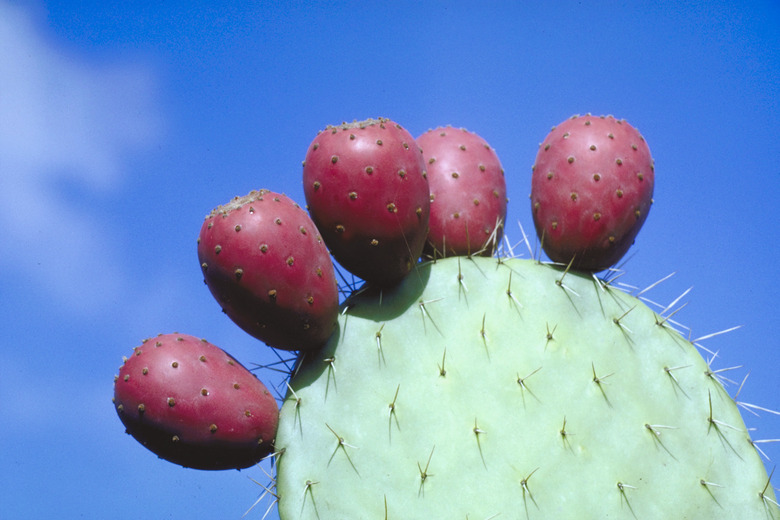How To Know When A Prickly Pear Is Ripe?
The sweet, oval fruits that grow on the tips of prickly pear cacti (Opuntia spp.) pads provide a colorful temptation for curious and hungry children in search of a snack in U.S. Department of Agriculture plant hardiness zones 3b through 11. Your mom sense, however, may worry about the ouch factor of the sharp spines and when the prickly pears are ripe for little tummies to enjoy. Alternately known as a tuna, cactus pear or Indian fig, their peak of ripeness only lasts about a week during the summer. Therefore, knowing the key indicators of maturity can help you schedule a family prickly pear harvest outing where you can supervise the safety of little fingers, and gather the best-quality fruits for healthy and nutritious snacks and juices.
Color
Step 1
The U.S. Department of Agriculture points to peel color as the most important indicator of a prickly pear's readiness for harvest. Immature fruits will be green. As they reach maturity, they will turn yellow, red, orange or purple, depending on the exact variety. The tuna reaches full ripeness in mid to late summer.
- The sweet, oval fruits that grow on the tips of prickly pear cacti (Opuntia spp.)
- Therefore, knowing the key indicators of maturity can help you schedule a family prickly pear harvest outing where you can supervise the safety of little fingers, and gather the best-quality fruits for healthy and nutritious snacks and juices.
Glochid Separation
Step 1
The prickly pear cacti grow long whitish-gray spines with tiny spines around their base, called glochids. Their soft, fuzzy appearance masks their sharpness. When these glochids separate from the pad and fall off, the fruit is ready to harvest. The University of California Davis Small Farms Program recommends twisting the fruit to remove it from the pad rather than pulling on it to avoid damaging the fruit.
Size
Step 1
Mature prickly pear berries grow 2 to 3 inches long and 2 inches wide. At full development, the fruit should be about half the size of an orange, according to the University of California Davis Small Farms Program. As many as 30 blooms can grow on mature pads, although 8 to 16 allow the fruit to develop to the optimum size.
- The prickly pear cacti grow long whitish-gray spines with tiny spines around their base, called glochids.
- The University of California Davis Small Farms Program recommends twisting the fruit to remove it from the pad rather than pulling on it to avoid damaging the fruit.
Firmness
Step 1
The Utah State University Cooperative Extension recommends choosing prickly pears that are firm to the touch. The USDA confirms that firmness indicates mature fruit. It adds that the best color and flavor comes from picking the prickly pears as near to fully ripe as possible, when the peel comes off easily and more pulp exists than seed.
References
- UC Davis Postharvest Technology: Cactus (Prickly) Pear: Recommendations for Maintaining Postharvest Quality
- University of California Cooperative Extension Small Farm Program: Prickly Pear Cactus Production
- U.S. Department of Agriculture Agricultural Research Service: Prickly Pear
- Food $ense: Prickly Pear Cactus
- Ladybird Johnson Wildflower Center: Opuntia humifusa
